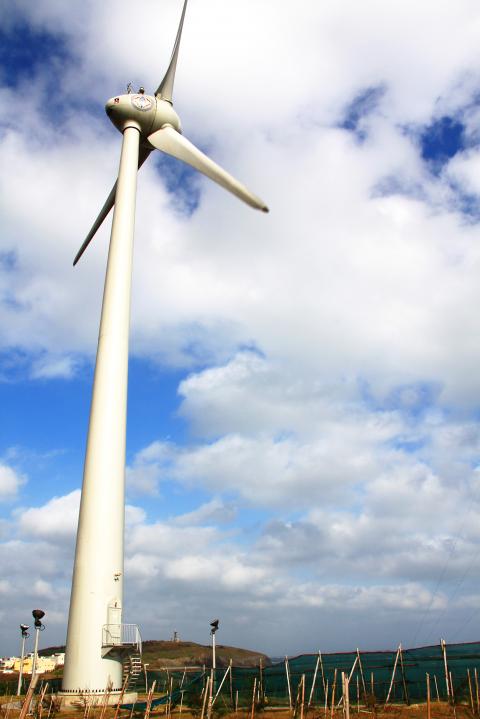While strong winds may be a bane for tourism in Penghu during winter, they may yet prove to be an economic boon once the 45m tall wind power turbines and submarine power cables are all installed by 2016, which could generate as much as NT$13 billion (US$434 million) a year in electricity, academics estimate.
At present, giant wind turbines spin at two sites on the island — near the coasts of Baisha Township’s (白沙) Jhongtun Village (中屯) and Husi Township’s (湖西) Peiliao Village (北寮). Both wind power sites are operated by state-owned Taiwan Power Co (Taipower).
Penghu’s power consumption is about 40,000 watts, Chien Shan Power Station deputy director Ou Chih-cheng (歐致誠) said, adding that the two power stations could already generate 10,000 watts, accounting for about one-fourth of the island’s energy demand.

Photo: Lee I-chia, Taipei Times
“During winter, wind speeds can sometimes get up to 20m/s [meters per second]. Since a wind velocity of 13m/s or 14m/s is enough for the generated power to reach full load, there are more than 150 days in a year in which the power generated by turbines reaches full load,” he said, adding that the full load rate was about 43 percent.
Ou said that the electricity generated from the two stations in 2010 added up to about 11 percent of the island’s total electricity supply. Not only do the turbines reduce the cost of power-generation, they also contribute to carbon reduction, which is in line with the government’s aim of turning Penghu into a world-class low-carbon island.
Yeh Kuo-ching (葉國清), director-general of the county’s Economic Affairs Bureau, said that once the construction of a submarine power cable between Taiwan proper and Penghu is completed in 2016, more wind turbines will be installed on the island and the surplus electricity generated will be sold back to Taiwan proper.
Aside from the spinning wind turbines operated by Taipower, state-of-the-art wind turbine technology experiments are also taking place on the island.
In 2007, National Penghu University of Science and Technology began a project commissioned and funded by the National Science Council to establish a 5,000m2 Wind Park at its campus for educational and research purposes.
The park is free for companies that want to test their wind turbines. It now hosts 47 small, experimental wind turbines installed by 20 companies worldwide. All the turbines have their own monitoring systems, which record their condition and efficacy and are transmitted by Internet for analysis and further improvement.
The university’s former president, Lin Huei-jeng (林輝政), now a professor at National Taiwan University’s Department of Engineering Science and Ocean Engineering and who led the program, said that based on data from 2008, “the average wind speed in Penghu was 9.75m/s and the wind gets stronger during winter months, increasing to about 16m/s, which is nearly the wind speed of a mild typhoon [17.2m/s to 32.6m/s].”
He said the strong winds on Penghu can put the companies’ newest designs to the test.
“Some companies were very confident about the [quality] of their turbines when they were installing them in the park, but after a few weeks, they found their blades broken, or their monitoring systems had malfunctioned, or [the blades] could not spin at all,” he said.
The school has received funding from the Ministry of Economic Affairs’ Bureau of Standards, Metrology and Inspection to set up another world-standard wind park in the campus. If it acquires international certification in October, it will be the second site in Taiwan qualified to issue official test reports.
Lin said Penghu can look forward to an estimated NT$13 billion in energy output each year from its wind power stations and the submarine power cable in the future, as well as reducing its dependence on fossil fuel.
With a wind power load of between 41 percent and 49 percent, Penghu is ahead of Germany with 25 percent, Denmark’s 28 percent, the UK’s 29 percent and Taiwan proper’s 30 to 35 percent, the National Science Council said.
Despite the optimism over the future of wind power on the island, some of its residents have expressed doubts and their opposition to the projct.
According to a local newspaper, the Penghu Times, residents have complained that the continuous spinning of the turbines creates noise pollution, while others question whether the power cable and substations might produce electromagnetic radiation, posing a threat to public health.

A group of Taiwanese-American and Tibetan-American students at Harvard University on Saturday disrupted Chinese Ambassador to the US Xie Feng’s (謝鋒) speech at the school, accusing him of being responsible for numerous human rights violations. Four students — two Taiwanese Americans and two from Tibet — held up banners inside a conference hall where Xie was delivering a speech at the opening ceremony of the Harvard Kennedy School China Conference 2024. In a video clip provided by the Coalition of Students Resisting the CCP (Chinese Communist Party), Taiwanese-American Cosette Wu (吳亭樺) and Tibetan-American Tsering Yangchen are seen holding banners that together read:

UNAWARE: Many people sit for long hours every day and eat unhealthy foods, putting them at greater risk of developing one of the ‘three highs,’ an expert said More than 30 percent of adults aged 40 or older who underwent a government-funded health exam were unaware they had at least one of the “three highs” — high blood pressure, high blood lipids or high blood sugar, the Health Promotion Administration (HPA) said yesterday. Among adults aged 40 or older who said they did not have any of the “three highs” before taking the health exam, more than 30 percent were found to have at least one of them, Adult Preventive Health Examination Service data from 2022 showed. People with long-term medical conditions such as hypertension or diabetes usually do not

POLICE INVESTIGATING: A man said he quit his job as a nurse at Taipei Tzu Chi Hospital as he had been ‘disgusted’ by the behavior of his colleagues A man yesterday morning wrote online that he had witnessed nurses taking photographs and touching anesthetized patients inappropriately in Taipei Tzu Chi Hospital’s operating theaters. The man surnamed Huang (黃) wrote on the Professional Technology Temple bulletin board that during his six-month stint as a nurse at the hospital, he had seen nurses taking pictures of patients, including of their private parts, after they were anesthetized. Some nurses had also touched patients inappropriately and children were among those photographed, he said. Huang said this “disgusted” him “so much” that “he felt the need to reveal these unethical acts in the operating theater

Heat advisories were in effect for nine administrative regions yesterday afternoon as warm southwesterly winds pushed temperatures above 38°C in parts of southern Taiwan, the Central Weather Administration (CWA) said. As of 3:30pm yesterday, Tainan’s Yujing District (玉井) had recorded the day’s highest temperature of 39.7°C, though the measurement will not be included in Taiwan’s official heat records since Yujing is an automatic rather than manually operated weather station, the CWA said. Highs recorded in other areas were 38.7°C in Kaohsiung’s Neimen District (內門), 38.2°C in Chiayi City and 38.1°C in Pingtung’s Sandimen Township (三地門), CWA data showed. The spell of scorching